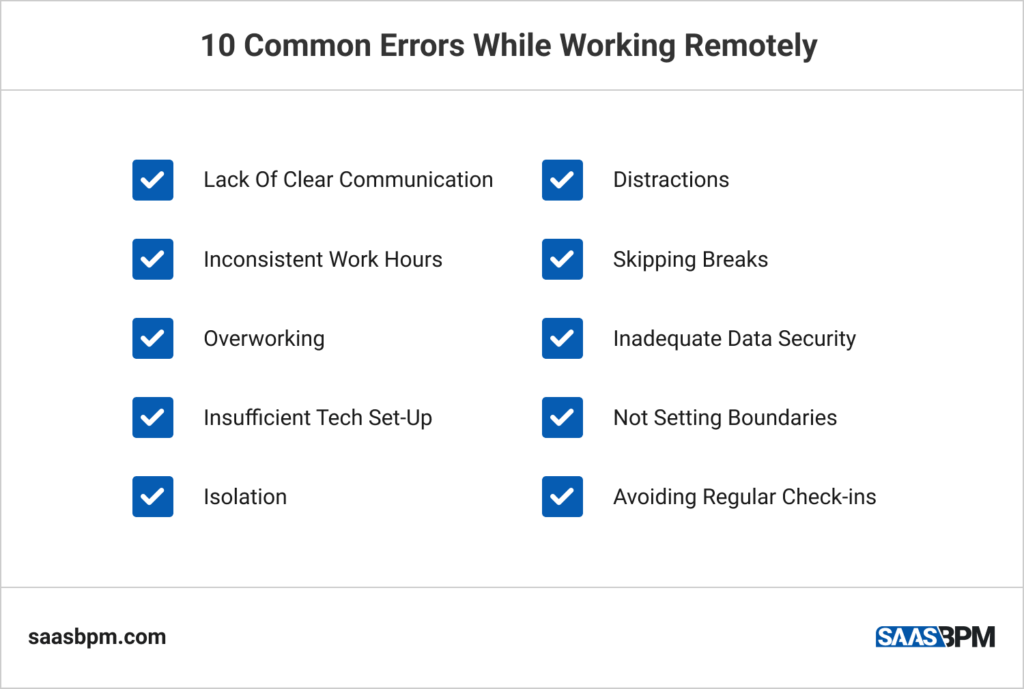The shift towards remote work has been dramatic and compelling. With the promise of flexibility, improved work-life balance, and broader opportunities, the allure is undeniable. After all, remote workers earn about $20K more on average than in-office employees. Yet, the world of remote work is not devoid of challenges.
One of the primary concerns revolves around effective communication. Without the spontaneous coffee break chats or face-to-face meetings that brick-and-mortar offices offer, there’s a risk of misunderstandings and processes becoming entangled. This can lead to inefficiencies, delayed projects, or even team friction.
Time management can offset some of these challenges, but to truly optimize remote operations, there’s a need for a more comprehensive solution. This is where business process management tools like SaaS BPM come in handy. The digital tool is designed to bridge communication gaps, simplify complex tasks, and provide a unified platform for team collaboration. By leveraging such software, remote teams can function seamlessly, ensuring that workflows are efficient, clear, and productive.
In this article, we will explore the perks working remotely comes with for employers and employees alike. Also, we will outline the most common errors people make when doing their tasks from home, and suggest viable solutions to fix them.
Why Is Working Remotely So Lucrative?

The concept of remote work has surged in popularity, offering benefits that have revolutionized traditional work models. Its attractiveness extends to both employers and employees, providing unique advantages that cater to the evolving needs of modern businesses and workforces.
For Employers
The financial benefits of adopting a remote work structure are substantial. By allowing employees to work from home or other locations, companies can drastically cut down on expenses such as rent, utilities, and general maintenance associated with physical office spaces. The savings here can be redirected to other essential facets of the business, aiding growth and expansion.
Beyond the financial aspect, the talent acquisition game changes dramatically. By not being tethered to a specific location, employers can reach out to talents across the globe. This not only broadens their access to a diverse talent pool but also brings in varied cultural perspectives, potentially offering innovative solutions to problems. Moreover, with a broader selection range, companies can be more selective, ensuring they get the right fit for specific roles, leading to reduced turnover and better team dynamics.
For Employees
The allure for employees to adopt a remote working lifestyle stems from both professional and personal reasons. At the forefront is the elimination of daily commutes. This not only saves time and money but also reduces the daily stress associated with navigating through traffic or crowded public transport systems.
Flexibility, a cornerstone of remote work, empowers employees to design their day around when they’re most productive. This personalization, which might not be feasible in a traditional 9-5 office setup, allows individuals to tap into their peak productivity hours, ensuring the quality of work is maintained or even enhanced.
Furthermore, remote work offers a chance for a more balanced life. Employees can spend more time with family, engage in hobbies, or even travel while still fulfilling their professional obligations. This balance often leads to happier, more content employees, which in turn, can translate to increased loyalty and dedication to their roles.
10 Common Errors While Working Remotely

The remote work model has revolutionized the traditional workplace. While it offers unparalleled flexibility and several other advantages, it is not without its challenges. Navigating these can be tricky, especially for those new to the remote work paradigm. Let’s delve into some of the most common pitfalls of working remotely and the nuances behind each.
Lack of Clear Communication
One of the primary challenges remote workers face is the absence of face-to-face interactions. This can result in miscommunications, misunderstandings, or essential details being overlooked. Without the luxury of dropping by a colleague’s desk to clarify, misinterpretations can arise, affecting project outcomes and team dynamics.
Inconsistent Work Hours
The freedom that remote work offers can be a double-edged sword. Without the structure of office hours, employees might adopt irregular work patterns. This inconsistency can hinder productivity, disrupt team collaboration, and offset synchronized efforts.
Overworking
The boundaries between personal and work life can often blur in a remote setting. Many find themselves working beyond typical hours, struggling to ‘switch off’. This extended work time, while seeming productive in the short run, can lead to exhaustion and burnout over prolonged periods.
Insufficient Tech Set-Up
Remote work is heavily reliant on technology. A subpar setup, whether it’s outdated hardware or glitchy software, can severely impede tasks. This not only leads to delays but can also cause mounting frustration, undermining the efficiency that remote work is supposed to offer.
Isolation
Human beings are inherently social creatures. The isolation of working remotely, devoid of office banter or impromptu team lunches, can lead to feelings of loneliness. Over time, this detachment can impact mental well-being and dampen team spirit.
Distractions
Home, while comfortable, hosts a myriad of distractions. From playful pets demanding attention to the allure of household chores or TV shows, staying focused can sometimes be a herculean task. These constant interruptions can lead to fragmented work and reduced efficiency.
Skipping Breaks
The structured environment of an office has its cues – like seeing a colleague step out for a coffee break. Remote work lacks these, often leading individuals to forgo regular breaks. This continuous work can strain the eyes, reduce concentration, and negatively impact overall productivity.
Inadequate Data Security
Relying on personal devices or unsecured home networks can be risky. With rising cyber threats, this can expose sensitive company data to potential breaches, compromising both individual and organizational security.
Not Setting Boundaries
The always-accessible nature of remote work can be invasive. Answering calls or replying to emails well past work hours can erode personal time, disrupting the work-life balance that remote work promises.
Avoiding Regular Check-ins
While autonomy is a perk of remote work, avoiding regular team check-ins can be detrimental. It can create feelings of being out-of-the-loop and can make collaborative efforts cumbersome. Regular touchpoints ensure everyone is aligned, fostering a sense of community and shared purpose, even from a distance.
Wrapping Up
The realm of remote work offers a plethora of benefits, but it also presents unique challenges. Being cognizant of common mistakes and taking proactive measures to counteract them is crucial for a smooth and efficient work-from-home experience. Leveraging the right tools and strategies, coupled with a deep understanding of potential hurdles, can make remote work equally, if not more, productive than conventional office setups. As the global workforce increasingly gravitates towards this model, addressing its inherent challenges head-on will pave the way for enduring success and satisfaction.

